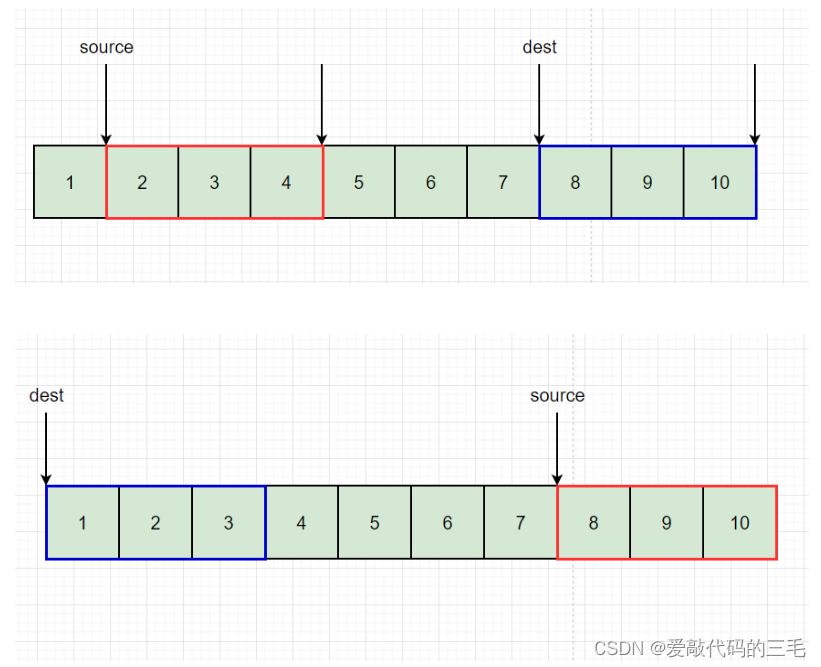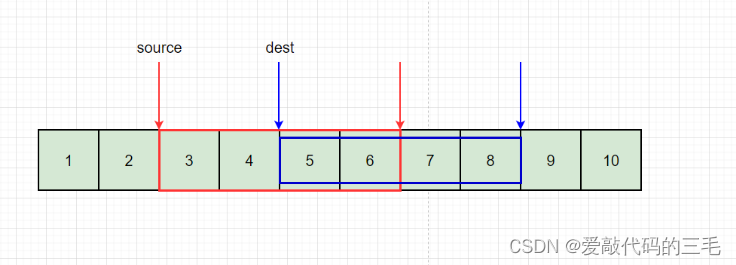-
梦开始的地方 —— C语言内存函数memcpy-memmove-memset(使用+模拟实现)
内存函数
1.memcpy
memcpy是C语言提供的复制内存块的函数,和字符拷贝函数strcpy有点像,但是strcpy只适用于字符,而memcpy适用整形、浮点型等于各种类型的数据拷贝。它有三个参数:
- destination:拷贝的目的地
- source:要拷贝的源字符串
- num:要拷贝的字节个数
void * memcpy ( void * destination, const void * source, size_t num );- 1
注意
- C语言标准规定,memcpy适用于两块不同内存空间的拷贝
- 当
destination和source有重叠的时候,结果是不可预计的, - 这个函数在遇到
\0的时候并不会停下来 - 该函数需要头文件
#include
#include#include int main() { int arr[20] = { 1,2,3,4,5 }; int array[] = { 6,7,8,9,10}; memcpy(arr+5, array, 20); int i = 0; for (i = 0; i < 10; i++) { printf("%d ", arr[i]); } return 0; } - 1
- 2
- 3
- 4
- 5
- 6
- 7
- 8
- 9
- 10
- 11
- 12
- 13
- 14
- 15
- 16
memcpy函数模拟实现
这里的实现是按照C语言标准规定,因为这里是从前向后拷贝,如果这里拷贝同一块空间的内容就会出现覆盖的情况。而有些编译使用memcpy函数对同一块空间内容进行拷贝,也不会出现覆盖的情况,但不能保证所有编译器都能不覆盖。
void* my_memcpy(void* destination, const void* source, size_t num) { assert(destination && source); void* ret = destination; while (num--) { *(char*)destination = *(char*)source; ++(char*)destination; ++(char*)source; } return ret; }- 1
- 2
- 3
- 4
- 5
- 6
- 7
- 8
- 9
- 10
- 11
- 12
- 13
2.memmove
memmove也是内存块拷贝函数,他和memcpy的区别就是
destination和source两个块空间可以重叠,不会出现覆盖情况void * memmove ( void * destination, const void * source, size_t num );- 1
#include#include #include int main() { int arr[20] = { 1,2,3,4,5 }; memmove(arr+2,arr,20); int i = 0; for (i = 0; i < 7; i++) { printf("%d ", arr[i]); } printf("\n"); return 0; } - 1
- 2
- 3
- 4
- 5
- 6
- 7
- 8
- 9
- 10
- 11
- 12
- 13
- 14
- 15
- 16
- 17
- 18
memmove函数模拟实现
- C语言标准规定,该函数可以对对同一块内存空间进行操操作
- 那么就需要考虑到两种情况,重叠和不重叠情况
如果拷贝的空间不重叠,从后向前或者是从前向后都没啥问题的

如果内存空间有重叠就得重后向前拷贝,如果从前向后拷贝有些数据就会被覆盖。
比如这里先把6拷到8的位置,再把5拷到7的位置。就不会被覆盖,如果从前往后拷贝,那么5和6就会被直击覆盖

模拟实现代码
#includevoid* my_memmove(void* destination, const void* source, size_t num) { assert(destination && source); void* ret = destination; //不冲突情况 if (((char*)source) + num < destination || ((char*)destination) + num < source) { //从前往后拷贝 while (num--) { *((char*)destination) = *((char*)destination); ++((char*)destination); ++((char*)source); } } else { //如果有冲突,从后往前拷贝 while (num--) { *(((char*)destination) + num) = *(((char*)source) + num); } } return ret; } - 1
- 2
- 3
- 4
- 5
- 6
- 7
- 8
- 9
- 10
- 11
- 12
- 13
- 14
- 15
- 16
- 17
- 18
- 19
- 20
- 21
- 22
- 23
- 24
- 25
- 26
- 27
3. memset
memset是C语言提供的内存块填充函数,它有三个参数
- ptr:填充的起始地址
- value:要填充的元素
- num:填充多少个字节
void * memset ( void * ptr, int value, size_t num );- 1
简单示例
#include#include int main() { char str[20] = "hello world!"; printf("%s\n", str); memset(str, '#', 5); printf("%s\n", str); return 0; } - 1
- 2
- 3
- 4
- 5
- 6
- 7
- 8
- 9
- 10
- 11
- 12
输出
hello world! ##### world!- 1
- 2
如果我们填充整形?
#include#include int main() { int arr[20] = { 1,2,3,4,5,6 }; memset(arr, 1, 4); printf("%d\n", arr[0]); return 0; } - 1
- 2
- 3
- 4
- 5
- 6
- 7
- 8
- 9
- 10
- 11
输出结果
16843009- 1
这里填充1,每个字节都填充了1
arr数组名是首元素地址,在内存中arr[0]占四个字节,我们这里是VS2019的X86环境,是小端存储
内存中存储的是16进制,那么就是 01 00 00 00,没两个16进制位表示一个字节
所以填充完后,就是 01 01 01 01 ,转换为10进制就是 16843009
memset函数模拟实现
#includevoid* my_memset(void* ptr, int value, size_t num) { assert(ptr != NULL); void* ret = ptr; while (num--) { *((char*)ptr) = value; ++((char*)ptr); } return ret; } - 1
- 2
- 3
- 4
- 5
- 6
- 7
- 8
- 9
- 10
- 11
- 12
- 13
- 14
-
相关阅读:
【RTOS训练营】程序框架、预习、课后作业和晚课提问
边缘计算 KubeEdge+EdgeMash
我的十年编程路 2017年篇
Django模型(一)
自拟实现消息队列(MQ)基于Rabbit MQ(含概念和源码)巨详细!!!!!含思维导图
nginx安装与配置反向代理
记一次排查线上MySQL死锁过程,不能只会curd,还要知道加锁原理
纯 Java 撸个后台管理系统,这框架用起来贼好
1python模块和库
Kafka高性能
- 原文地址:https://blog.csdn.net/weixin_53946852/article/details/127817290
